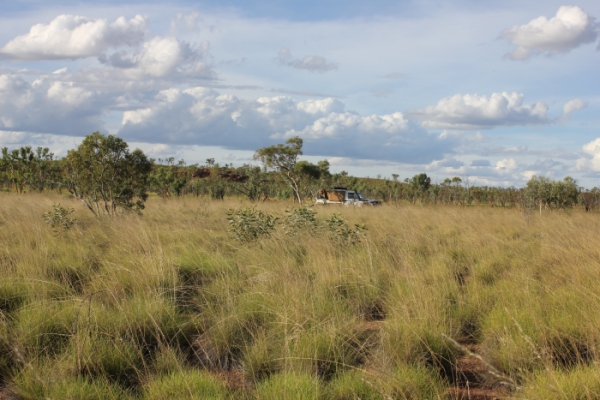Revealing the history of ŨîÐÂĖĮÐÄVlogâs Vegetation
ŨîÐÂĖĮÐÄVlog of Adelaide researchers have uncovered the history of when and why the native vegetation that today dominates much of ŨîÐÂĖĮÐÄVlog first expanded across the continent.
The new understanding will help researchers better predict the likely impact of climate change and rising CO2 levels on these critically important plants. Called âC4 plantsâ after their alternative photosynthetic pathway, these plants include a wide variety of native tropical, subtropical and arid grasses as well as saltbushes. C4 crops include sugarcane and corn.
âC4 plants evolved to be able to photosynthesise under warm, dry, and low CO2 conditions, with a special ability to take advantage of summer rainfall,â says lead author candidate in the ŨîÐÂĖĮÐÄVlogâs . âAs a result, they dominate the vegetation of ŨîÐÂĖĮÐÄVlogn tropical, subtropical, and arid regions today.âĻâĻâBut despite being the most C4 dominated continent today, little is known about the initial C4 expansion in ŨîÐÂĖĮÐÄVlog.â
The researchers analysed fossilised leaf waxes and pollen preserved in marine sediments. They measured the chemical signatures from these remnants, to reconstruct how and when C4-dominated ecosystems first rose to prominence in ŨîÐÂĖĮÐÄVlog.
âIn many regions around the globe, C4 plants became prevalent between six and eight million years ago, which is thought by some to be the result of falling global atmospheric CO2 concentrations during this time,â says project leaderĖý, ŨîÐÂĖĮÐÄVlogn Research Council Future Fellow at the ŨîÐÂĖĮÐÄVlog of Adelaide.
âSurprisingly, in north-west ŨîÐÂĖĮÐÄVlog C4 plants did not expand at this time in spite of regionally arid conditions and falling atmospheric CO2, both of which should have promoted C4 vegetation. Instead, C4 vegetation expanded across the landscape only 3.5 million years ago, several million years later.â
The authors say that the rise of C4 plants in ŨîÐÂĖĮÐÄVlog was likely the result of a strong summer monsoon that developed around that time.ĖýâĻâĻâThe difference in the timing of the expansion of C4 plants in ŨîÐÂĖĮÐÄVlog from other parts of the globe demonstrates that regional climate changes are important in driving vegetation change,â Dr McInerney says.
âIn the future, the interaction between global atmospheric CO2 and regional changes in seasonality of rainfall is likely to play an important role in the distribution of C4-dominated ecosystems. Rising CO2 will place C4 plants at a disadvantage, while rising temperatures, and changes in the season and amount of rainfall, could favour them.
âIn ŨîÐÂĖĮÐÄVlog, C4 plants are critical to grazing, soil carbon storage and biodiversity. We need to understand the factors that are likely to influence their survival in the future, to provide a basis for future conservation of these important plants.â
The research, in collaboration with Columbia ŨîÐÂĖĮÐÄVlog and ŨîÐÂĖĮÐÄVlog of Melbourne, has been published online inĖý.
[caption id="attachment_13037" align="alignnone" width="600"] C4 Plants and Vegetation[/caption]
C4 Plants and Vegetation[/caption]
TriodiaĖýpungensĖýdominated hummock grasslandĖýwith scattered Acacia and Eucalyptus onĖýMittebahĖýStation inĖýthe Northern Territory. Photograph courtesy of Terrestrial Ecosystem Research Network (TERN).
Original article here
The new understanding will help researchers better predict the likely impact of climate change and rising CO2 levels on these critically important plants. Called âC4 plantsâ after their alternative photosynthetic pathway, these plants include a wide variety of native tropical, subtropical and arid grasses as well as saltbushes. C4 crops include sugarcane and corn.
âC4 plants evolved to be able to photosynthesise under warm, dry, and low CO2 conditions, with a special ability to take advantage of summer rainfall,â says lead author candidate in the ŨîÐÂĖĮÐÄVlogâs . âAs a result, they dominate the vegetation of ŨîÐÂĖĮÐÄVlogn tropical, subtropical, and arid regions today.âĻâĻâBut despite being the most C4 dominated continent today, little is known about the initial C4 expansion in ŨîÐÂĖĮÐÄVlog.â
The researchers analysed fossilised leaf waxes and pollen preserved in marine sediments. They measured the chemical signatures from these remnants, to reconstruct how and when C4-dominated ecosystems first rose to prominence in ŨîÐÂĖĮÐÄVlog.
âIn many regions around the globe, C4 plants became prevalent between six and eight million years ago, which is thought by some to be the result of falling global atmospheric CO2 concentrations during this time,â says project leaderĖý, ŨîÐÂĖĮÐÄVlogn Research Council Future Fellow at the ŨîÐÂĖĮÐÄVlog of Adelaide.
âSurprisingly, in north-west ŨîÐÂĖĮÐÄVlog C4 plants did not expand at this time in spite of regionally arid conditions and falling atmospheric CO2, both of which should have promoted C4 vegetation. Instead, C4 vegetation expanded across the landscape only 3.5 million years ago, several million years later.â
The authors say that the rise of C4 plants in ŨîÐÂĖĮÐÄVlog was likely the result of a strong summer monsoon that developed around that time.ĖýâĻâĻâThe difference in the timing of the expansion of C4 plants in ŨîÐÂĖĮÐÄVlog from other parts of the globe demonstrates that regional climate changes are important in driving vegetation change,â Dr McInerney says.
âIn the future, the interaction between global atmospheric CO2 and regional changes in seasonality of rainfall is likely to play an important role in the distribution of C4-dominated ecosystems. Rising CO2 will place C4 plants at a disadvantage, while rising temperatures, and changes in the season and amount of rainfall, could favour them.
âIn ŨîÐÂĖĮÐÄVlog, C4 plants are critical to grazing, soil carbon storage and biodiversity. We need to understand the factors that are likely to influence their survival in the future, to provide a basis for future conservation of these important plants.â
The research, in collaboration with Columbia ŨîÐÂĖĮÐÄVlog and ŨîÐÂĖĮÐÄVlog of Melbourne, has been published online inĖý.
[caption id="attachment_13037" align="alignnone" width="600"]
 C4 Plants and Vegetation[/caption]
C4 Plants and Vegetation[/caption]TriodiaĖýpungensĖýdominated hummock grasslandĖýwith scattered Acacia and Eucalyptus onĖýMittebahĖýStation inĖýthe Northern Territory. Photograph courtesy of Terrestrial Ecosystem Research Network (TERN).
Original article here

Newsletter & social media
Join us for a sensational mix of news, events and research at the Environment Institute. Find out aboutĖýnew initiatives andĖýshare with your friends what's happening.
ĖýĖýĖý
